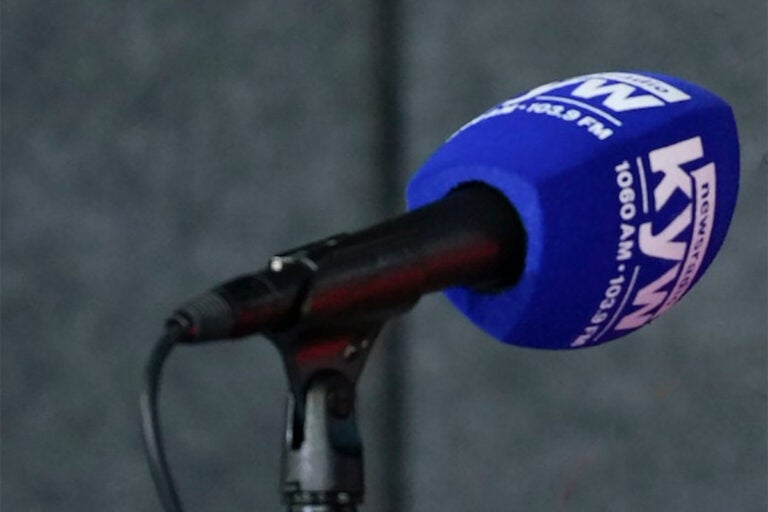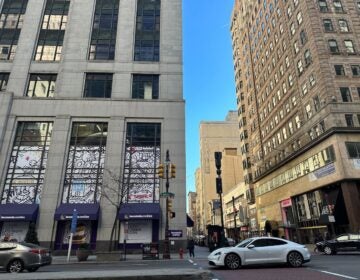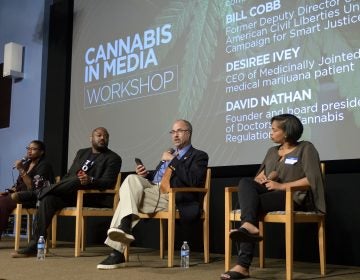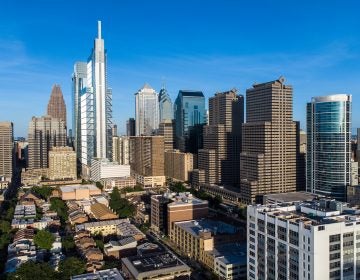Here’s what to know about the bankruptcy of KYW radio’s parent company Audacy
Fewer flustered commuters on the roadways nationwide since the COVID-19 pandemic is one reason Audacy says it filed for Chapter 11 bankruptcy protection.
Listen 1:11
KYW's parent company has filed for bankruptcy. (AP Photo/Matt Rourke, File)
From Philly and the Pa. suburbs to South Jersey and Delaware, what would you like WHYY News to cover? Let us know!
Philadelphia-based radio and podcasting giant Audacy Inc. filed for Chapter 11 bankruptcy protection over the weekend.
Its CEO, David Field, said it was the result of a “perfect storm of macroeconomic challenges” in a news release.
In 2002, Field was promoted to CEO of the company his father started back in the late 1960s, formerly known as Entercom Communications. In 2017, Field purchased CBS Radio for $1.5 billion, with hopes that the market would grow and he’d be able to repay the debt.
Field declined an interview for this news story through an Audacy spokesperson.
The company’s corporate headquarters sit on Market Street in Center City, near the Schuylkill River and traffic congestion often caused by I-76 commuters.
For decades, Audacy relied on people stuck in their cars eager to tune into traffic, weather and news for its commercial radio station operation, KYW, or a dedicated sports talk radio station, WIP-FM — before, during, and after their work days.
It has grown to operate more than 200 radio stations nationwide including its flagship in Philadelphia but also in Pittsburgh, Boston, Chicago, Detroit, Kansas City, Los Angeles, Minneapolis, New York City, San Francisco and St Louis. The company more recently invested in podcasts.
Now Audacy is restructuring $1.9 billion in debt through a prepackaged bankruptcy reorganization. The company plans to reduce its debt down to $350 million as a result.
Much of its debt on the books was tied to the CBS Radio acquisition — a total of $1.4 billion — but despite cutting $310 million in costs since the deal closed Audacy wasn’t able to make a significant dent in its debt.
Had the company not filed for bankruptcy, it would have owed $103 million in cash payments on its debt in 2022 and another $120.6 million in 2023.
The prepackaged bankruptcy means there’s a special deal where the company gets $57 million in new capital known as debtor-in-possession financing.
Audacy still needs court approval to emerge from the prepackaged bankruptcy — which requires the broadcaster to repay creditors. It also needs regulatory approval from the Federal Communications Commission.
The general perspective of the business was shared in bankruptcy filings.
“The COVID-19 pandemic caused a precipitous decline in the morning and evening weekday commutes, which significantly reduced audiences in those prime time, or drive time, segments,” Audacy attorneys wrote. “At the same time, advertisers — Audacy’s customers — reduced marketing spending, leading to declining revenues. While the return-to-office push should support a rebound in radio listenership, it continues to be well below pre-pandemic levels, particularly in the largest markets where Audacy’s operations are concentrated.”
In 2022, Audacy employed more than 3,500 full-time and 1,400 part-time workers. It leased more than 67,000 square feet for its corporate office on the 2400 block of Market Street that will expire in July 2024, according to U.S. Securities and Exchange Commission records.
The core issue is the transition from traditional broadcast radio to a digital media business model, which according to Dan Day, analyst at B Riley Securities in New York City, is a pennies on the dollar proposition. Day covered Audacy before it was delisted from the NASDAQ stock exchange in 2023.
“They’ll never recreate the economics of broadcast radio in podcast,” Day said. “They don’t have the leverage over the talent that they had when they controlled the distribution assets, which they don’t anymore.”
For example, the pitch a legacy nationwide radio station owner has for the plethora of digital podcasters is access to exposure leveraging any unsold spots for promotion on its airwaves. Or the business could offer to sell stand alone ads against the podcast.
“The value that they provide is more like a music label,” Day said.
Beyond that market shift, since the COVID-19 pandemic began almost four years ago, there are fewer commuters than ever stuck in that traffic broadcasters count on when listeners are likeliest to tune in.
Audacy’s overall revenues — now bolstered by its bet on podcasting and digital media in addition to legacy radio stations — had not bounced back since even 2019, before the COVID-19 pandemic began. For example, Audacy generated $1.5 billion in revenue in 2019.
Meanwhile, the compound annual growth rate for broadcast radio advertising dropped by 6% between 2019 and 2022 in markets where Audacy has active stations like Philadelphia, according to the company’s bankruptcy court records.
“Despite recent headwinds, management is optimistic about the future and Audacy’s investments in digital media,” according to the company. “However, Audacy’s transformation into a multi-platform audio content provider has taken longer than can be sustained under the debtors’ current capital structure.”
Commercial radio ad sales mostly flatlined nearly 20 years ago, said analyst Day.
“Now you’ve got a million ways you can specifically target [an] audience on the internet and tie it back directly to sales,” Day said about retail advertising campaigns.
But there’s still demand for brand awareness — such as the type used in political campaigns or general consumer goods like food and beverages.
“People may overstate the structural problems of the actual [commercial radio] business,” he said. “If you take a totally unleveraged radio company, a lot of them are doing pretty attractive cash flows. There’s always demand for things like broadcast TV, radio and cable TV, that’s always going to be there.”
And for local businesses, it’s a mainstay for direct advertising for a geographic audience, Day said.
“The cost you’re getting per thousand impressions are much cheaper [on the radio] than they are on TV,” he said. “You might be like an HVAC business or dentist or lawyer. The reason those guys advertise on radios is because there’s still a lot of people tuning in.”

Get daily updates from WHYY News!
WHYY is your source for fact-based, in-depth journalism and information. As a nonprofit organization, we rely on financial support from readers like you. Please give today.






